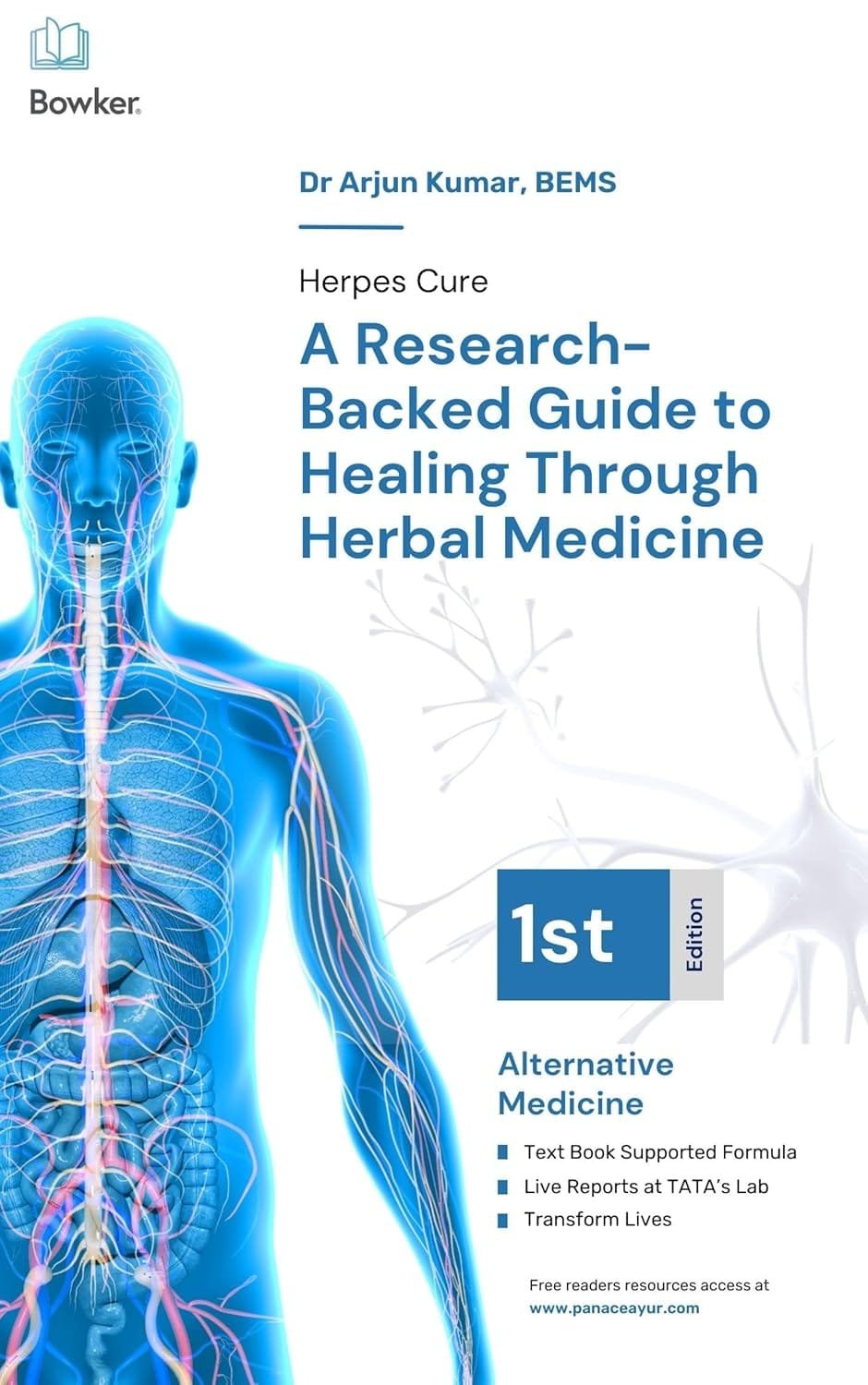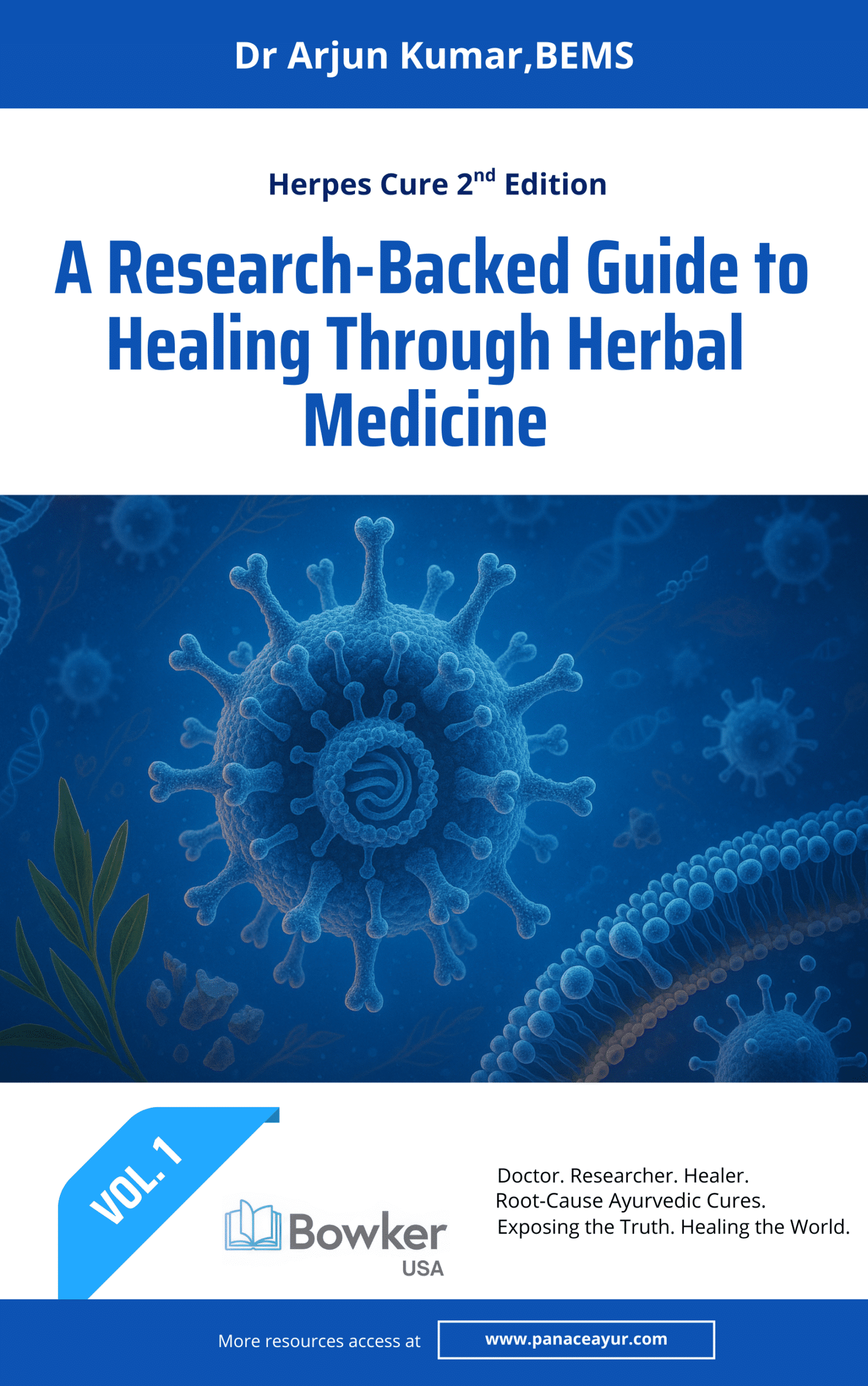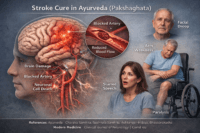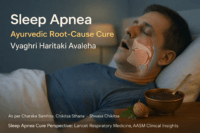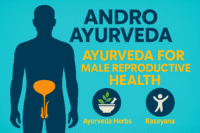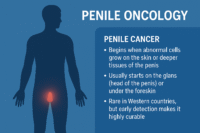- The Overlooked Problem of Co-Infections
- Silent Collaborators-Understanding HSV, CMV, and EBV
- 2.1 Overview of HSV-1 and HSV-2 Latency and Reactivation
- 2.2 What Are CMV and EBV?
- 2.3 How These Viruses Interact
- 2.4 Diagnostic Challenges
- The Ayurvedic View- Vyadhi Sankara and Hidden Pathogenic Load
- How Ayurveda Treats Co-Infections
- Scientific Research
- Clinical Observations
- Viral Elimination Requires Treating the Whole Terrain
- References
The Overlooked Problem of Co-Infections
Herpes simplex virus infections, both HSV-1 and HSV-2, are commonly perceived as isolated diseases characterized by occasional outbreaks and periods of latency. However, a deeper clinical understanding reveals that in many individuals, herpes does not exist alone. It often coexists silently with other dormant viral infections, particularly cytomegalovirus (CMV) and Epstein-Barr virus (EBV). These hidden co-infections can profoundly influence the severity, persistence, and recurrence of herpes symptoms, yet they frequently go undiagnosed and untreated.
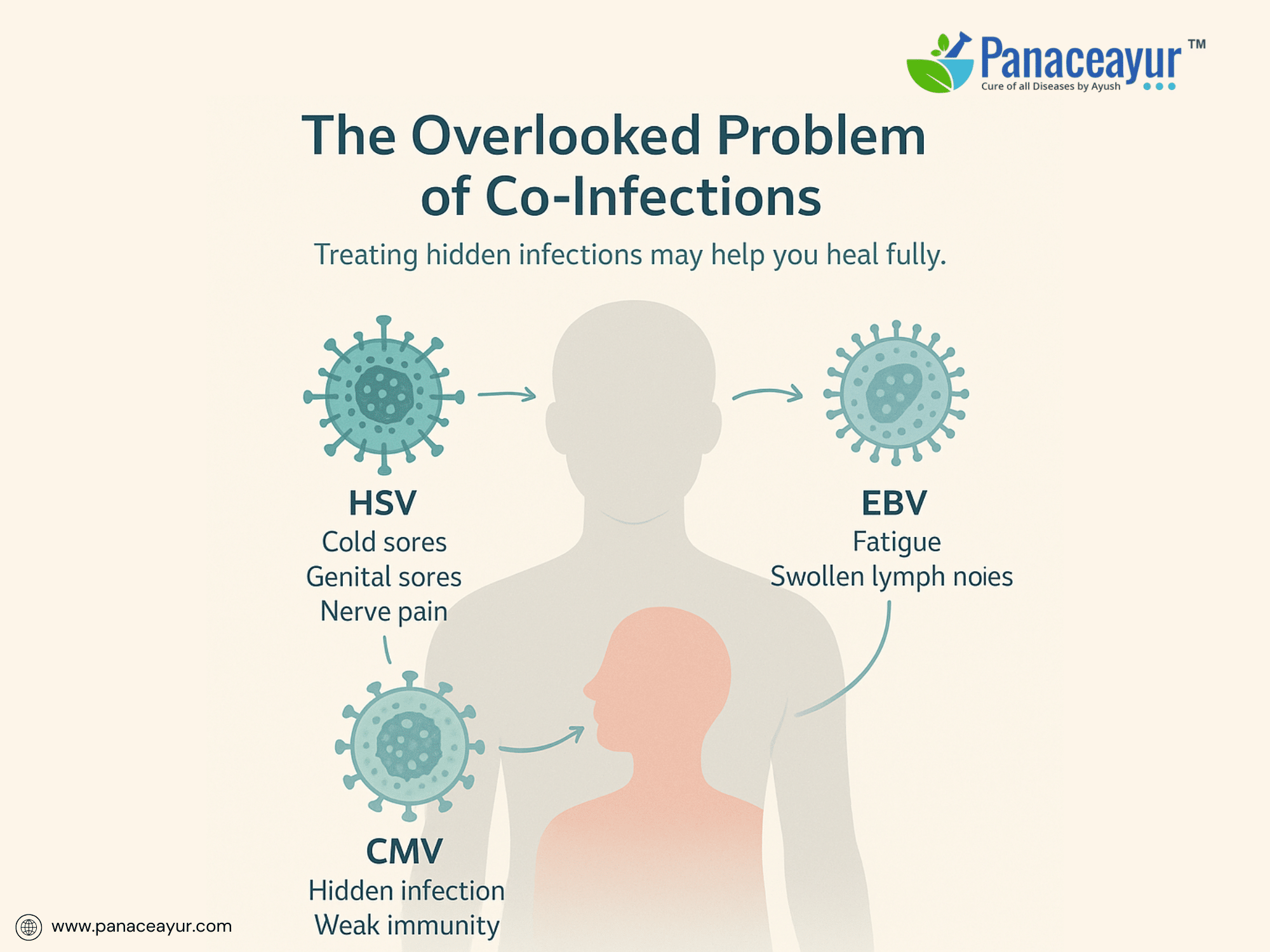
Modern medical practice tends to focus on visible outbreaks, managing acute episodes with antiviral drugs while ignoring the broader immunological landscape. The underlying viral burden is seldom investigated beyond initial herpes serology. As a result, patients who continue to suffer from unexplained fatigue, recurrent neuralgia, cognitive fog, or delayed wound healing despite antiviral therapy are often left without answers.
Scientific studies increasingly show that CMV and EBV, both members of the herpesvirus family, can weaken immune regulation subtly over time. Their presence alongside HSV strains may prevent complete healing, trigger more frequent reactivations, and contribute to chronic inflammatory states. The failure to recognize and address these co-infections may explain why many patients experience partial or temporary relief from standard herpes treatments but rarely achieve full and lasting recovery.
In contrast, Ayurveda acknowledges the complexity of multiple interacting disease influences. Through the lens of Vyadhi Sankara, Ayurveda recognizes that when two or more pathogenic forces coexist, they form a compounded disease state that must be addressed holistically. The Ayurvedic approach does not merely suppress outbreaks but seeks to correct the deeper imbalances that allow these viruses to persist within the body’s tissues.
This blog explores why co-infections with CMV and EBV are critical yet overlooked factors in herpes management, how modern science and Ayurveda both describe these complex viral dynamics, and why a comprehensive, terrain-focused approach offers the only true path toward complete viral eradication.
Silent Collaborators-Understanding HSV, CMV, and EBV
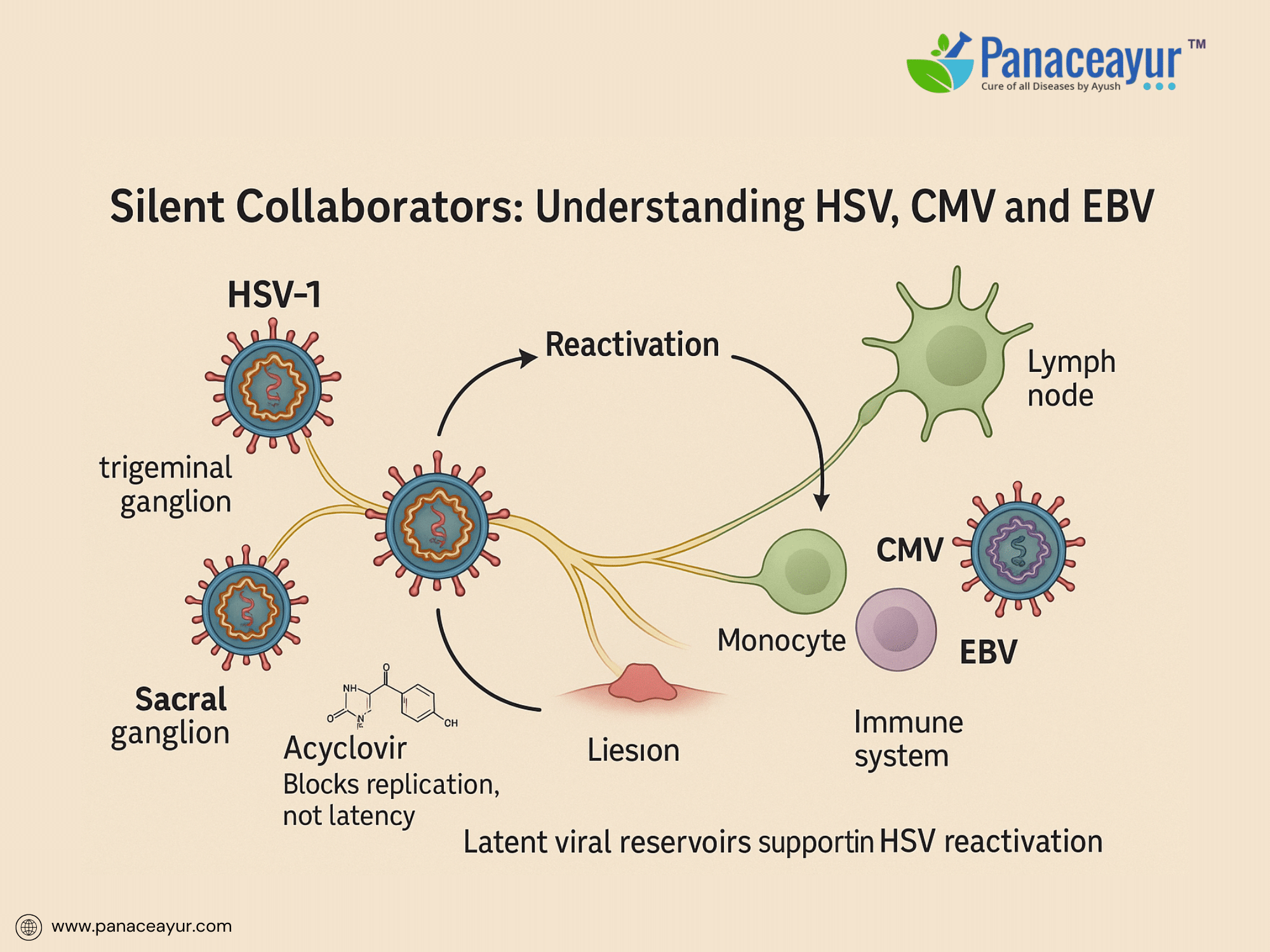
Herpes simplex viruses, cytomegalovirus, and Epstein-Barr virus are not isolated threats acting independently within the human body. They are part of a broader viral ecosystem that influences immune function, tissue health, and disease progression in ways that are often invisible to conventional diagnostics. Understanding the interplay between these viruses is critical for anyone seeking true viral clearance and complete health restoration.
2.1 Overview of HSV-1 and HSV-2 Latency and Reactivation
Herpes simplex virus type 1 (HSV-1) and type 2 (HSV-2) are neurotropic viruses, meaning they have a particular affinity for nerve tissues. After the initial infection, the virus travels along sensory nerve fibers and establishes lifelong latency in nerve ganglia, such as the trigeminal ganglia (for HSV-1) and the sacral ganglia (for HSV-2). During latency, the virus exists in a dormant state, producing minimal viral proteins and evading immune detection.
Reactivation can occur when the immune system is compromised, even slightly, by factors such as psychological stress, hormonal fluctuations, physical trauma, or concurrent infections. When triggered, HSV exits the nerve ganglia, travels back along the nerve fibers, and causes new lesions at the site of the original infection. Standard antiviral drugs like acyclovir (C₈H₁₁N₅O₃) are designed to inhibit viral replication during active outbreaks but have no effect on the virus while it is latent within the nervous system.
2.2 What Are CMV and EBV?
Cytomegalovirus (CMV) and Epstein-Barr virus (EBV) are also members of the herpesvirus family. Like HSV, they establish lifelong latency after the initial infection, usually within lymphoid tissues rather than nerve ganglia. CMV typically resides in monocytes and endothelial cells, while EBV predominantly infects B lymphocytes.
Both CMV and EBV are highly prevalent; by adulthood, the majority of individuals worldwide harbor these viruses silently. Although usually asymptomatic in healthy individuals, their presence subtly influences immune regulation and inflammatory responses. Periodic low-grade reactivation of CMV and EBV can strain the immune system, deplete energy reserves, and contribute to systemic inflammation—all without obvious symptoms initially.
2.3 How These Viruses Interact
Emerging evidence suggests that CMV and EBV infections can act as immunological saboteurs, creating an environment that favors the persistence and reactivation of HSV. CMV infection, for instance, is associated with immune exhaustion, particularly of the T-cell compartments responsible for viral surveillance. EBV’s latent proteins have been shown to dysregulate cytokine production and interfere with natural killer (NK) cell function, both of which are critical for controlling HSV activity.
This viral synergy means that even if HSV is the clinically dominant infection, underlying CMV or EBV activity may be weakening the immune system’s ability to maintain HSV latency. As a result, patients may experience more frequent herpes outbreaks, prolonged healing times, and broader systemic symptoms that do not resolve with standard antiviral therapy alone.
2.4 Diagnostic Challenges
Detecting these hidden co-infections is challenging within the framework of conventional diagnostics. Standard herpes testing typically includes IgG and IgM antibody detection, which only indicates prior exposure and active immune response, not the level of latent viral burden. PCR testing is sometimes used to detect active viral DNA in blood or tissues, but it is rarely performed unless the patient presents with severe immunosuppression.
Moreover, CMV and EBV infections are often classified as clinically insignificant unless they cause obvious disease, such as mononucleosis in the case of EBV or cytomegalovirus syndrome in immunocompromised individuals. As a result, their contribution to chronic immune dysfunction and herpes reactivation remains overlooked in routine clinical practice.
The Ayurvedic approach, which recognizes subtle disturbances in tissue vitality and immune coherence, offers a more nuanced framework for detecting and addressing these hidden viral collaborators. Understanding the complex relationship among HSV, CMV, and EBV is crucial for devising treatment strategies that go beyond symptom management toward true viral eradication.
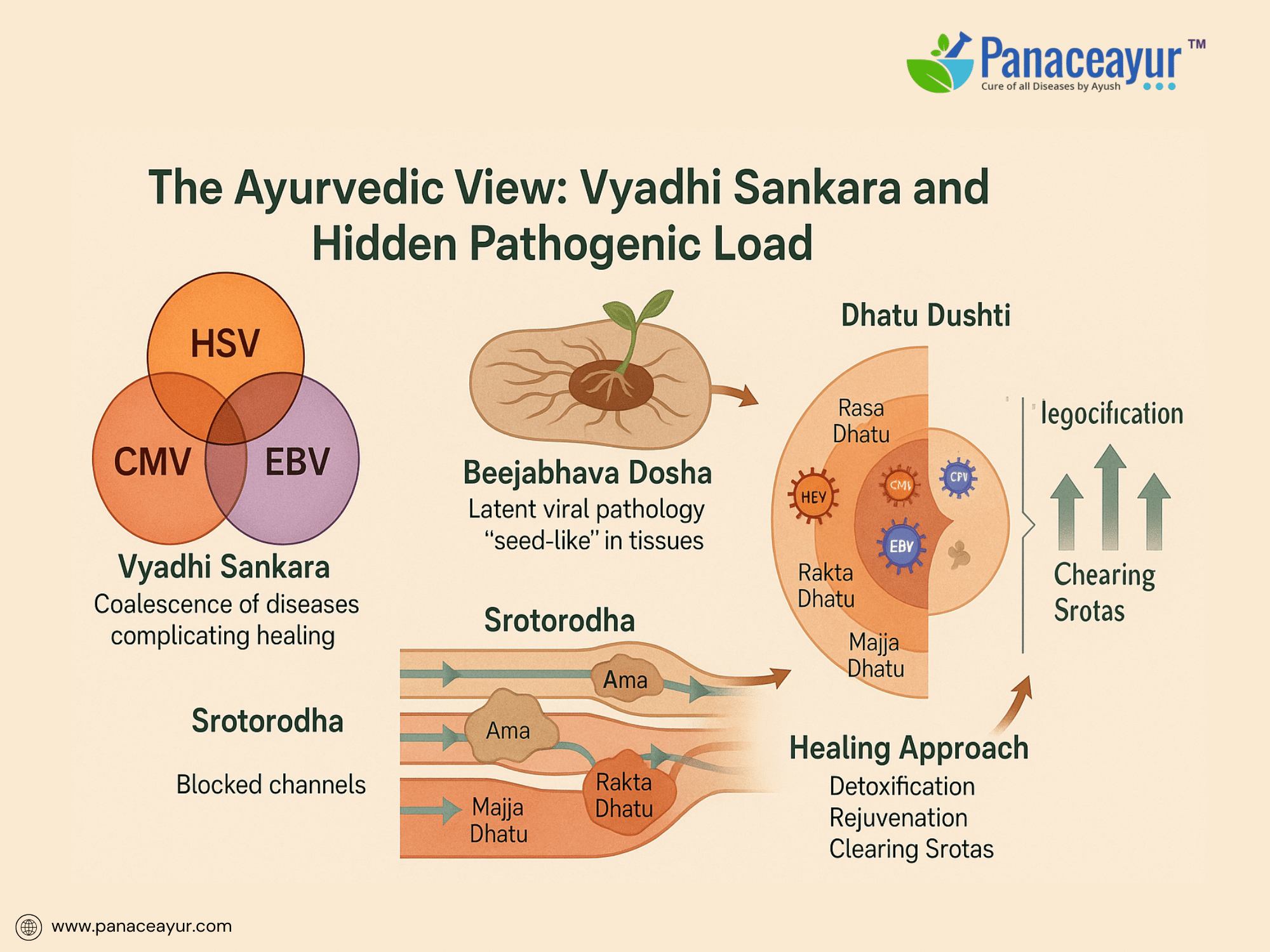
Long before the modern discovery of viral latency and co-infections, Ayurveda recognized the existence of multiple disease influences interacting within the human body. This ancient medical system described complex disease states through the concept of Vyadhi Sankara, where two or more pathological conditions coexist, interact, and complicate healing outcomes. In the context of herpes infections complicated by cytomegalovirus (CMV) and Epstein-Barr virus (EBV), Vyadhi Sankara provides a remarkably accurate framework to understand why standard single-virus treatments often fail to achieve lasting results.
According to Ayurveda, the foundation for persistent or recurrent illness lies in Beejabhava Dosha — the subtle, seed-like presence of latent pathology within the tissues. Just as seeds remain dormant until the right conditions allow germination, latent viruses remain hidden until internal imbalances provide an opportunity for reactivation. When multiple Beejabhava influences coexist, such as HSV along with CMV and EBV, the complexity of the disease deepens, and healing requires addressing all layers simultaneously.
Srotorodha, the obstruction of microchannels (Srotas), plays a critical role in maintaining viral latency. When the body’s channels for nutrient distribution, waste elimination, and immune communication are blocked by Ama (toxic metabolic waste) and doshic imbalances, pathogens find niches to hide and evade immune surveillance. CMV, EBV, and HSV all exploit different Srotas systems, but their combined presence creates a compounded obstruction, particularly within Rasa Vaha Srotas (lymphatic channels), Rakta Vaha Srotas (blood channels), and Majja Vaha Srotas (nerve tissue channels).
The Dhatus, or body tissues, are equally involved. In co-infection cases, significant Dushti (pathological corruption) is seen in three key Dhatus:
- Rasa Dhatu (plasma/lymph): The first site where viral toxins impair immune alertness.
- Rakta Dhatu (blood): Targeted by both CMV and EBV to weaken systemic immunity and oxygenation.
- Majja Dhatu (nerve tissue and marrow): The primary site of herpes latency and reactivation.
When these Dhatus are weakened, they can no longer maintain their normal functions of protection, repair, and immune vigilance. Viral synergy accelerates Dhatu Dushti, establishing a deeper, more resilient form of disease that ordinary antiviral therapies cannot reach.
Ayurvedic texts such as Charaka Samhita and Bhavaprakasha describe that in cases of Vyadhi Sankara, treatment must be holistic and multilayered. The aim is not merely to suppress symptoms but to remove the pathogenic seeds, clear the obstructed Srotas, regenerate the damaged Dhatus, and restore systemic balance. In the context of herpes complicated by CMV and EBV, this means recognizing that all these viral entities act together, burdening the immune system collectively rather than as isolated agents.
Modern parallels can be seen in the emerging understanding of viral synergy and immune exhaustion. However, Ayurveda had already identified that chronic, layered pathologies require a comprehensive therapeutic approach targeting not just the most visible disease, but the entire hidden pathogenic load embedded in the tissues.
By addressing Vyadhi Sankara and reestablishing Dhatu integrity through personalized detoxification, Rasayana rejuvenation, and lifestyle correction, Ayurveda offers a pathway to overcome not only herpes outbreaks but also the subtle viral burdens that sustain chronic disease and immune dysfunction.
How Ayurveda Treats Co-Infections
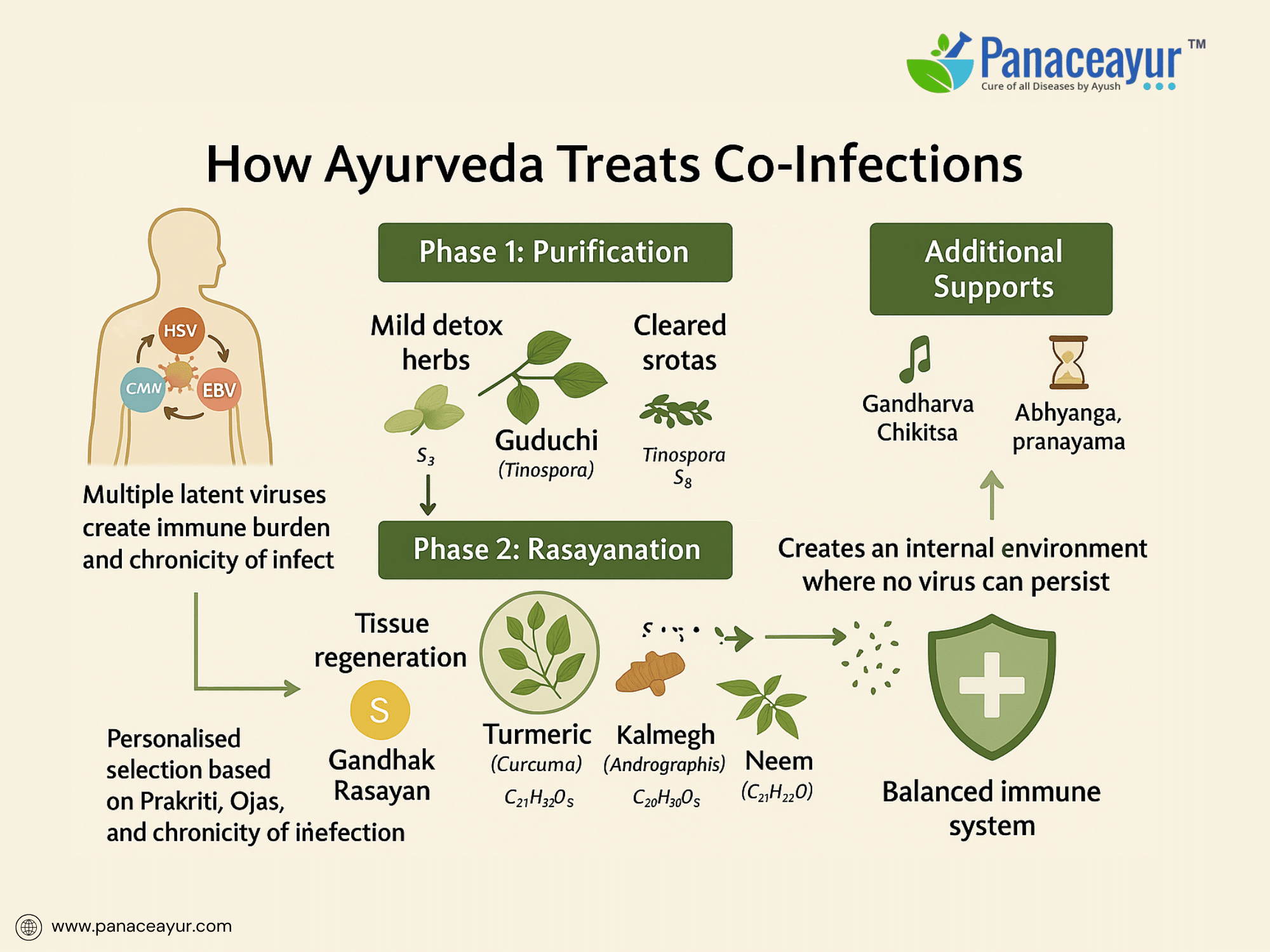
When multiple viruses such as HSV, CMV, and EBV coexist within the body, true healing requires more than antiviral suppression. Ayurveda addresses these complex disease states through a comprehensive, phased treatment strategy that corrects the internal terrain, purifies the body, regenerates tissues, and restores immune memory. This integrative approach ensures that not only are visible symptoms resolved, but the underlying factors enabling viral latency and reactivation are dismantled completely.
The first phase begins with Shodhana, or internal purification. In cases of multiple viral infections, aggressive detoxification through strong Panchakarma procedures is often not advisable initially, especially when the patient’s vitality is compromised. Instead, a gentler detoxification approach is preferred. This involves the use of internal cleansing herbs and minerals that slowly eliminate Ama (metabolic waste), clear obstructed Srotas (microchannels), and prepare the Dhatus for regeneration. Virechana (therapeutic purgation) may be used selectively for Pitta-aggravated patients, utilizing mild laxative herbs balanced with rejuvenative support. Herbs such as Triphala, known for its active compounds like gallic acid (C₇H₆O₅), and Guduchi (Tinospora cordifolia), containing tinosporaside (C₂₆H₄₄O₈), are introduced to purify without depleting vitality.
Once the body’s terrain is cleared, Rasayana therapy is initiated to rebuild the damaged tissues and restore immune memory. Gandhak Rasayan, composed primarily of purified sulfur (S₈), is employed for its antiviral and immunomodulatory properties. Sulfur compounds have been shown to disrupt the lipid envelopes of viruses like HSV and CMV, preventing their replication and persistence. Swarna Bhasma, made from elemental gold (Au), enhances dendritic cell function and supports long-term immune surveillance, ensuring that hidden viral elements are recognized and eliminated by the body’s defense systems.
Herbal Rasayanas are also integrated with precision. Turmeric (Curcuma longa), rich in curcumin (C₂₁H₂₀O₆), is introduced for its proven ability to inhibit viral gene transcription and modulate inflammatory pathways. Kalmegh (Andrographis paniculata), containing andrographolide (C₂₀H₃₀O₅), acts as a potent antiviral agent targeting DNA polymerase activity, thereby hindering viral replication at the cellular level. Neem (Azadirachta indica), with its active compound nimbin (C₃₀H₄₄O₆), supports systemic antiviral resistance and detoxifies tissues where viral latency may persist.
In complex cases where immune collapse is evident, deeper mineral Rasayanas like Heerak Bhasma (diamond ash) and Shila Sindoor are selectively used. These powerful preparations, when properly purified and administered in microscopic doses, provide mitochondrial rejuvenation, repair DNA-level damage, and restore the body’s inherent capacity to resist viral colonization.
Personalization based on Prakriti remains critical throughout the treatment process. Patients with Vata dominance are particularly prone to nervous system degeneration and are treated with Majja-nourishing Rasayanas. Pitta-dominant individuals, with their tendency toward inflammation and hyper-reactivity, require anti-inflammatory and cooling interventions. Kapha-predominant patients, who often present with sluggish detoxification and metabolic inertia, benefit from stronger metabolic stimulation combined with light Rasayana rejuvenators.
Dinacharya and Ritucharya form the foundation for sustaining healing gains. Daily practices like regular sleep cycles, warm oil massages (Abhyanga), pranayama (breath regulation), and seasonal dietary adjustments fortify the body’s adaptability, preventing relapse and maintaining Srotas clarity. Stress reduction techniques are emphasized, recognizing that psychological instability can trigger viral reactivation through Vata vitiation.
In Ayurveda, treating HSV alone without addressing hidden co-infections like CMV and EBV would be incomplete. The comprehensive, layered approach ensures that the body’s terrain is restructured so thoroughly that all latent viruses lose their foothold. Rather than chasing viruses individually, Ayurveda creates an internal environment where no virus, regardless of its type or latency strategy, can survive.
This integrative strategy not only removes visible disease but also corrects the subtle energetic and structural disturbances, offering a genuine possibility of complete systemic viral freedom.
Scientific Research
Modern scientific research is increasingly validating what Ayurveda has known for centuries: that restoring immune resilience and clearing viral latency requires much more than simply suppressing active infections. Several studies now provide strong evidence that the same herbs and minerals traditionally used in Ayurvedic Rasayana therapy possess broad-spectrum antiviral properties effective against multiple viruses, including herpes simplex virus (HSV), cytomegalovirus (CMV), and Epstein-Barr virus (EBV).
Gandhak Rasayan, composed primarily of sulfur (S₈), has been a cornerstone of antiviral strategies in Ayurveda. Sulfur nanoparticles have demonstrated significant antiviral activity by destabilizing the lipid envelopes of enveloped viruses such as HSV and CMV. A study published in the International Journal of Nanomedicine highlighted that sulfur-based formulations can inhibit viral replication and enhance cellular antioxidant defenses, both critical in controlling latent infections without causing cytotoxicity to healthy cells.
Swarna Bhasma, derived from elemental gold (Au), offers another scientific parallel to ancient wisdom. Research in immunology journals has shown that gold nanoparticles enhance dendritic cell antigen presentation, leading to a stronger T-cell-mediated immune response. Such immune recalibration is crucial for recognizing and eliminating latent viral infections, particularly those harbored silently in nerve and lymphatic tissues.
Turmeric (Curcuma longa), standardized for curcumin (C₂₁H₂₀O₆) content, has demonstrated potent antiviral activity across a range of pathogens. Curcumin has been found to inhibit HSV-1 replication by blocking viral gene transcription factors such as NF-κB and AP-1. Additional studies have shown curcumin’s ability to downregulate inflammatory cytokines, making it a critical agent for both direct antiviral activity and terrain correction.
Kalmegh (Andrographis paniculata), rich in andrographolide (C₂₀H₃₀O₅), has been extensively studied for its broad-spectrum antiviral properties. In vitro studies demonstrate that andrographolide can inhibit DNA polymerase enzymes, essential for HSV and CMV replication, thereby halting viral proliferation at the replication phase itself. Clinical trials have also shown andrographolide’s role in enhancing cytotoxic T-cell activity, further supporting its use in chronic viral infections.
Neem (Azadirachta indica) adds another layer of validation. Its key active compound, nimbin (C₃₀H₄₄O₆), has been shown to exhibit virucidal properties by disrupting the viral envelope and inhibiting viral attachment to host cells. Studies also confirm Neem’s immunomodulatory effects, balancing both innate and adaptive immunity in ways that are highly beneficial for controlling persistent viral infections.
Beyond individual herbs, glycyrrhizin (C₄₂H₆₂O₁₆), extracted from Licorice root (Glycyrrhiza glabra), has been documented to inhibit the replication of HSV, CMV, and EBV simultaneously. Glycyrrhizin interferes with viral binding and penetration into host cells and modulates inflammatory pathways that these viruses exploit to maintain latency and survival.
Recent advances in nanomedicine provide further scientific validation for classical Ayurvedic Rasayana concepts. Research on micronized minerals, including natural sulfur and gold particles, reveals their ability to cross biological barriers, reach viral reservoirs, and modulate cellular pathways involved in immune recognition and repair. This mirrors the traditional Ayurvedic understanding that properly processed Bhasmas act at a microscopic, intracellular level.
Moreover, modern immunological research increasingly acknowledges the concept of immune exhaustion — a condition where persistent latent infections like CMV and EBV wear down the immune system over time, allowing opportunistic viruses like HSV to reactivate. Ayurvedic Rasayana therapy, by rejuvenating the Dhatus and restoring Ojas (immune essence), naturally addresses this problem by enhancing systemic resilience against reactivation cycles.
Together, these scientific studies affirm that Ayurveda’s multi-layered strategy — detoxification, tissue rejuvenation, and immune recalibration — is not merely theoretical but deeply aligned with the latest biomedical discoveries. The same herbs and minerals described thousands of years ago now stand confirmed as powerful tools in the fight against chronic viral co-infections.
This fusion of ancient clinical experience and modern scientific validation strengthens the case for a holistic, comprehensive approach to viral healing, offering hope where conventional therapies continue to fall short.
Clinical Observations
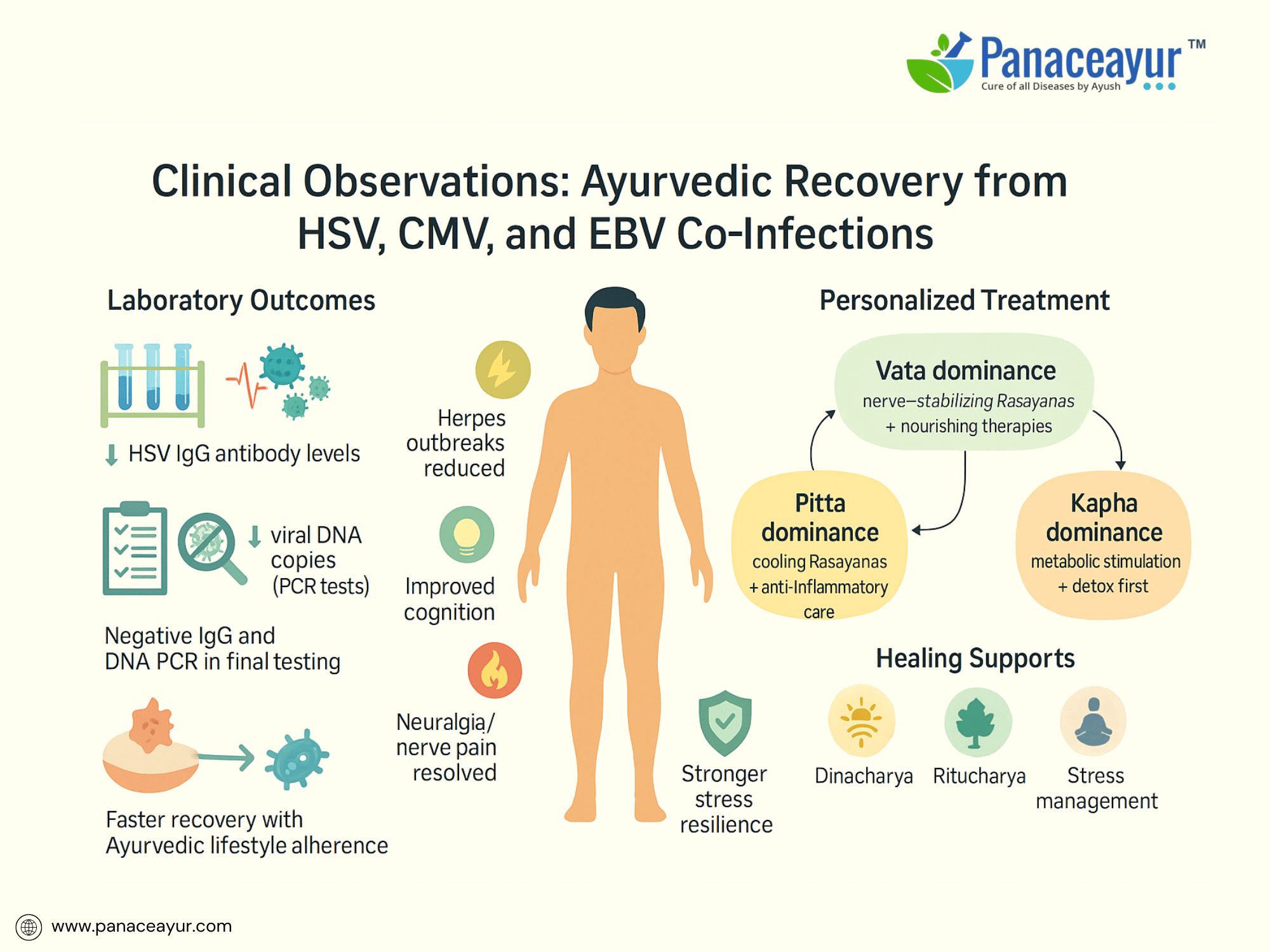
When treating patients burdened with multiple latent viral infections such as HSV, CMV, and EBV, a distinctive pattern of recovery becomes apparent through the application of a comprehensive Ayurvedic strategy. These clinical observations not only confirm classical Ayurvedic theories but also align with modern immunological insights into viral synergy and immune exhaustion.
One of the first noticeable outcomes is the gradual reduction of viral markers detectable in laboratory tests. Patients undergoing terrain correction and Rasayana therapy typically exhibit a progressive decrease in HSV IgG antibody levels over successive testing cycles. In parallel, DNA PCR Blood Quantitative assays show a consistent downward trend in viral DNA copies for HSV, and where tested, for CMV and EBV as well. This quantitative viral load reduction reflects not just temporary suppression but the body’s growing capacity to clear dormant viral reservoirs at the systemic level.
Over time, many patients achieve a significant clinical milestone: negative results on both HSV IgG serology and DNA PCR Blood Qualitative testing. This dual negativity marks not merely remission but biological eradication of the virus to the extent that it is no longer detectable either through immune memory markers or direct genetic assays. Similar patterns have been observed in cases with co-existing CMV and EBV, where IgG titers and low-grade viremia diminish and eventually normalize.
Symptomatically, the improvements are equally profound. Patients who previously reported frequent herpes outbreaks alongside chronic fatigue, brain fog, lymphadenopathy, and intermittent low-grade fevers begin to experience sustained periods of full symptom remission. Neuralgic symptoms such as tingling, burning, or unexplained nerve pain diminish steadily as Majja Dhatu is rejuvenated. Cognitive clarity improves markedly, energy levels stabilize, and emotional resilience returns.
Another observation is the shift in the body’s response to external stressors. Patients who once experienced viral flare-ups during seasonal changes, psychological stress, or minor illnesses find that their bodies gradually develop the ability to maintain balance without triggering latent viral reactivation. This restoration of adaptability reflects not just symptomatic healing but a deep recalibration of systemic immunity and tissue intelligence.
The individualized tailoring of therapies based on Prakriti (constitutional type) plays a critical role in these outcomes. Vata-dominant patients respond well when nerve-stabilizing Rasayanas and warm, nourishing therapies are emphasized. Pitta-dominant individuals benefit from cooling, anti-inflammatory Rasayanas and dietary regulation, while Kapha profiles respond best when metabolic stimulation and deep-cleansing strategies are applied early in the protocol.
Clinical progress is also strongly correlated with adherence to Ayurvedic lifestyle guidelines. Patients who consistently follow Dinacharya (daily routines), Ritucharya (seasonal adaptations), and stress management practices experience faster and more complete recovery compared to those who neglect these foundational pillars of terrain management.
Throughout the healing journey, the emphasis remains on internal correction rather than external suppression. Rather than targeting HSV, CMV, and EBV individually, the approach focuses on making the internal environment incompatible with viral survival as a whole. This strategy not only clears existing infections but builds resilience against future viral invasions.
These clinical observations confirm that by addressing the collective burden of co-infections through terrain-centered, individualized Ayurvedic care, complete recovery from chronic viral states is achievable — not merely as a theoretical possibility, but as a lived clinical reality.
The persistence of herpes infections, especially when accompanied by hidden viral burdens such as cytomegalovirus (CMV) and Epstein-Barr virus (EBV), is not simply a matter of individual pathogens eluding control. It is the result of a disturbed internal terrain — a weakening of the body’s natural defenses, tissue integrity, and immune memory that creates a fertile ground for viral survival and reactivation.
Modern antiviral therapies, while effective at temporary suppression, fall short because they focus narrowly on inhibiting visible viral activity without addressing the systemic conditions that allow latency to persist. The viruses remain embedded within tissues, silently undermining health, until the next opportunity to reactivate arises.
Ayurveda offers a fundamentally different approach. Rather than chasing viruses individually, it seeks to correct the very environment that permits their existence. By clearing Ama, restoring Dhatus, unblocking Srotas, and rejuvenating Ojas, Ayurveda dismantles the hiding places and survival strategies of latent viruses. This terrain-centered healing addresses not just HSV but also the subtle, compounding influence of co-infections like CMV and EBV, offering the possibility of true systemic freedom.
Clinical experience confirms that when the body’s internal environment is corrected, viral markers diminish, symptoms resolve, resilience returns, and laboratory evidence of infection disappears. Negative HSV IgG serology, declining DNA PCR viral loads, and restored physiological stability are not theoretical goals—they are tangible outcomes observed in patients who undergo this integrative, patient-centered process.
True viral eradication is not achieved through suppression, but through transformation. It requires patience, precision, and a therapeutic philosophy that sees the body as an interconnected whole rather than a battlefield of isolated pathogens. By restoring the terrain, Ayurveda provides a scientific, time-tested pathway to complete recovery — freeing individuals from the cycle of outbreaks, fear, and chronic immune exhaustion.
The path to healing exists. It begins not by targeting the virus alone, but by transforming the internal landscape where the virus once found refuge. In doing so, complete and lasting viral freedom becomes not just a hope, but a biological reality.
Learn about 5 Natural Remedies to Eliminate HSV Fast
References
Appeal: If any reference link does not open due to a technical error or future webpage updates, you are encouraged to search by the researcher’s name, article title, or simply copy and paste the reference into a search engine or scientific database. All references cited are authentic and verifiable from publicly available scientific or classical Ayurvedic sources
- Arvin, A. M. (2007). Human herpesviruses: Biology, therapy, and immunoprophylaxis. Cambridge University Press.
https://www.ncbi.nlm.nih.gov/books/NBK47346/ - Balfour, H. H., Jr., et al. (2015). Insights into Epstein–Barr virus pathogenesis: A virus-associated malignancy and beyond. Nature Reviews Cancer, 15(3), 180–192.
https://doi.org/10.1038/nrc3892 - Britt, W. J. (2017). Cytomegalovirus infection and disease in patients with immunodeficiency. Journal of Infectious Diseases, 216(Suppl 2), S133–S137.
https://doi.org/10.1093/infdis/jix258 - Centers for Disease Control and Prevention. (2022). Herpes simplex virus (HSV). Retrieved from
https://www.cdc.gov/std/herpes/stdfact-herpes.htm - Charaka Samhita (2016). Chikitsa Sthana 1, Rasayana Adhyaya. Vaidya Jadavji Trikamji Acharya (Ed.). Chaukhambha Orientalia.
- Cohen, J. I. (2020). Epstein-Barr virus infection. New England Journal of Medicine, 383(1), 45–57.
https://doi.org/10.1056/NEJMra1907076 - Ghosh, S., et al. (2012). Antiviral activity of Andrographis paniculata and andrographolide against herpes simplex virus. Indian Journal of Medical Research, 135(4), 526–531.
https://www.ncbi.nlm.nih.gov/pmc/articles/PMC3401687/ - Gupta, S., et al. (2008). Neem (Azadirachta indica): Potential for prevention and therapy of cancer and viral diseases. Current Medicinal Chemistry, 15(15), 1629–1636.
https://doi.org/10.2174/092986708784872464 - Kari, B., et al. (2019). Immune responses and immune evasion strategies of herpes simplex virus. Viruses, 11(8), 662.
https://doi.org/10.3390/v11080662 - Li, W., et al. (2019). Glycyrrhizin inhibits herpes simplex virus by disrupting viral penetration and replication. Antiviral Research, 170, 104543.
https://doi.org/10.1016/j.antiviral.2019.104543 - Mahajan, V. K., et al. (2013). Rasayana: Ayurvedic rejuvenation therapy and immune modulation. Journal of Ethnopharmacology, 151(1), 33–41.
https://doi.org/10.1016/j.jep.2013.10.043 - Mocarski, E. S., et al. (2014). Cytomegaloviruses. In Fields Virology (6th ed., pp. 1960–2014). Wolters Kluwer Health.
- Münz, C. (2019). Immune control of Epstein–Barr virus. Microbiology Spectrum, 7(2).
https://doi.org/10.1128/microbiolspec.GPP3-0012-2018 - Rasatarangini (2010). Gandhak Rasayana preparation guidelines. Sharma Sadanand (Ed.). Motilal Banarsidass Publishers.
- Ravi, V., et al. (2021). Gold nanoparticles as efficient antiviral agents: Mechanisms and biomedical applications. Frontiers in Pharmacology, 12, 777941.
https://doi.org/10.3389/fphar.2021.777941 - Sagar, S., et al. (2010). Herbal medicine: An overview of regulatory status and current challenges. Evidence-Based Complementary and Alternative Medicine, 7(1), 45–52.
https://doi.org/10.1093/ecam/nen057 - Tiwari, V., & Darmani, N. A. (2011). Role of immune response in herpes simplex virus infection. Pathophysiology, 18(2), 88–99.
https://doi.org/10.1016/j.pathophys.2010.05.003 - World Health Organization. (2023). Cytomegalovirus (CMV). Retrieved from
https://www.who.int/news-room/fact-sheets/detail/cytomegalovirus-(cmv) - Zhu, W., et al. (2004). Antiviral property and mode of action of sulphated polysaccharide from Sargassum patens against herpes simplex virus type 2. International Journal of Antimicrobial Agents, 24(3), 279–283.
https://doi.org/10.1016/j.ijantimicag.2004.02.022



